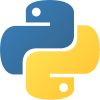21
DecPython Programming Examples
Python is one of the most beginner-friendly programming languages, known for its simple syntax and readability. Practicing Python programs is the best way to build a strong foundation and understand how Python logic works in real scenarios.
In this Python tutorial, you will explore some of the most commonly asked Python programs from basic arithmetic to string manipulation and number logic. Each example includes a code snippet, output, and a reference to detailed tutorials for better understanding. Enroll in our Learn Python for Free course and build in-demand skills today!
Python Programming Examples List
Here’s a categorized list of Python program examples that cover fundamental programming concepts, control flow, functions, and more. You can click each link to read the full tutorial with code and explanations.
1. Basic Python Programs
These are simple Python programs that help you get started with syntax, variables, and input/output operations.
| Program | Description | Link |
| Addition of Two Numbers | Learn how to add two numbers using Python input and arithmetic operators. | Addition of Two Numbers in Python |
| Swapping Two Numbers | Understand how to swap variables with and without using a temporary variable. | Swapping Two Numbers in Python |
| Run a Python Script | Learn how to execute Python programs from your terminal or IDE. | Run a Python Script: Step by Step Guide |
2. Number Programs in Python
Number-based programs are a great way to practice loops and conditionals in Python.
| Program | Description | Link |
| Prime Number Program | Check whether a number is prime using for loop and conditional statements. | Python Program to Check Prime Number |
| Leap Year Program | Determine if a given year is a leap year or not. | Program to Check Leap Year in Python |
| Armstrong Number | Check whether a number is an Armstrong number using mathematical operations. | Armstrong Number in Python |
| Factorial of a Number | Calculate the factorial of a number using loops and recursion. | Factorial Calculator in Python |
| Fibonacci Series | Generate Fibonacci sequence up to a given number using a loop. | Fibonacci Series in Python |
3. String Programs in Python
String programs teach how to manipulate text data, an essential skill in any programming task.
| Program | Description | Link |
| Reverse a String | Learn multiple ways to reverse strings using slicing and loops. | Reverse a String in Python |
| Sorting Strings or Numbers | Understand how Python’s sort() and sorted() functions work. | Sort in Python - An Easy Way to Learn |
4. Loop and Conditional Programs
Loops and conditionals form the backbone of programming logic. These examples reinforce concepts of iteration and control flow.
| Program | Description | Link |
| For Loop Example | Learn how for loops work in Python. | Python For Loops |
| While Loop Example | Understand while loops with practical examples. | Understanding Python While Loop |
| If-Else Statement Example | Learn how decision-making works in Python. | If Else Statement in Python |
5. Function arnd Recursion Examples
Functions make code reusable and organized. Recursion introduces a powerful problem-solving technique in Python.
| Program | Description | Link |
| Python Functions | Understand how to define and call functions with parameters. | Python Functions- Types and Examples |
| Recursion Example | Learn how recursive functions work with examples like factorial and Fibonacci. | Recursion in Python- A Detailed Explanation |
6. Additional Useful Concepts
Enhance your understanding with advanced Python tutorials that go beyond basic programs.
| Topic | Description | Link |
| Libraries in Python | Learn about standard and third-party libraries to extend Python functionality. | Libraries in Python- A Complete Resolution |
| Constructors in Python | Understand how constructors initialize objects in OOP. | Understanding Constructors in Python |
Conclusion
These Python programming examples are ideal for both beginners and intermediate learners. Start by understanding the problem, write your own solution, and then compare it with the linked examples. With consistent practice, you’ll gain confidence in Python syntax, logic, and problem-solving techniques.
90% of tech giants prefer full-stack talent. Enroll in our Full-Stack Python Course or risk missing out!90% of tech giants prefer full-stack talent. Enroll in our Full-Stack Python Course or risk missing out!
FAQs
- Understand concepts faster
- See real output immediately
- Learn by doing instead of memorizing
- Improve logic and problem-solving skills
- Common errors (IndentationError, TypeError, SyntaxError)
- Debugging using print() and breakpoints
- Reading error messages properly
- L – Read the problem logically
- T – Try solving without code
- E – Execute and test
- T – Try improving & optimizing
Take our Python skill challenge to evaluate yourself!

In less than 5 minutes, with our skill challenge, you can identify your knowledge gaps and strengths in a given skill.






